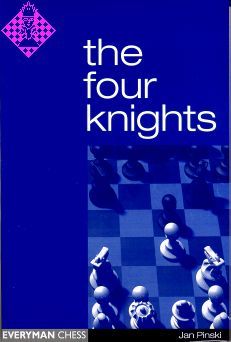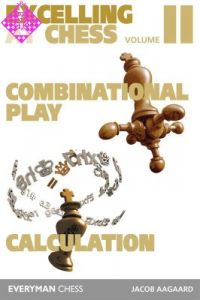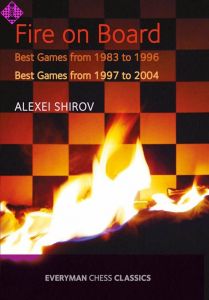Artikelnummer
LOPINTFK
Autor
The Four Knights
192 Seiten, kartoniert, Everyman, 2003
Final vergriffen
International Master Jan Pinski delves into the secrets of the Four Knights for the first time, studying the tactical and strategic ideas for both white and black players.
The Four Knights has the distinction of being one of the oldest openings in the history of chess. In a king's pawn opening, both players bring out their knights before contemplating further development. Despite its deceptively peaceful appearance, the Four Knights can lead to wild gambit play as well as calmer positional waters, while adherents include the renowned tactician from Latvia, Alexei Shirov.
In this new book, International Master Jan Pinski delves into the secrets of the Four Knights for the first time, studying the tactical and strategic ideas for both white and black players. Pinski covers both the fashionable main lines and the tricky sidelines, bringing the reader right up to date with the expanding theory.
Written by a leading openings expert
Covers both White's and Black's main options
A popular choice for club and tournament players
International Master Jan Pinski is a young and talented player from Poland, who is also well regarded as an openings theoretician. His earlier works for Everyman include Sicilian Kalashnikov (co-authored with the Danish International Master Jacob Aagaard) and Classical Dutch.
The Four Knights has made a comeback to the international chess circuit. Once it was used by the shameless in order to make a draw in a dozen or so moves, but now it has become a strong surprise weapon and a real alternative to the Ruy Lopez and other main openings. Based on home preparation and serious analysis it has been possible for top players to use this system to fight for an advantage. Objectively the different variations only give equality, but that is the eternal problem of openings. Against strong black defence, White cannot force an advantage. Chess is a fighting game where the better-prepared player will usually prove an advantage. That is why ancient and forgotten openings have come back into tournament chess. It is often possible to find a lot of new ideas in these openings from the 19th century, where the understanding of chess was far different from what it is today. I would like to recommend:
4 g3, the Glek System, for those who need an hour or so to recover from a party the evening before, before getting into the game.
4 d4 exd4 5 Nd5!? for those addicted to tricks and complications.
4 a3 as an advanced trick, but mainly for those who like absolutely no theory
4 d4 and 5 Nxd4 for a calm, positional and somewhat harmless game.
4 Bb5 for either a quiet, positional game or a real fireworks, depending on Black's response.
This book deals with many typical ideas and plans. Learning and understanding these is essential. They will help you when you enter into new territory, and they will also help you remember what you need to remember. I hope you enjoy reading the book as much as I enjoyed writing it.
Finally, I would like to thanks National Candidate Master Tomasz Olenderek for his kindness, and for letting me use his great archive of chess material. Special thanks for assistance, a critical viewpoint and the new idea 4 Bb5 Bd6 5 g4!? to National Master Rafal Przedmojski.
Jan Pinski Warsaw, April 2003, Introduction
The Four Knights has the distinction of being one of the oldest openings in the history of chess. In a king's pawn opening, both players bring out their knights before contemplating further development. Despite its deceptively peaceful appearance, the Four Knights can lead to wild gambit play as well as calmer positional waters, while adherents include the renowned tactician from Latvia, Alexei Shirov.
In this new book, International Master Jan Pinski delves into the secrets of the Four Knights for the first time, studying the tactical and strategic ideas for both white and black players. Pinski covers both the fashionable main lines and the tricky sidelines, bringing the reader right up to date with the expanding theory.
Written by a leading openings expert
Covers both White's and Black's main options
A popular choice for club and tournament players
International Master Jan Pinski is a young and talented player from Poland, who is also well regarded as an openings theoretician. His earlier works for Everyman include Sicilian Kalashnikov (co-authored with the Danish International Master Jacob Aagaard) and Classical Dutch.
The Four Knights has made a comeback to the international chess circuit. Once it was used by the shameless in order to make a draw in a dozen or so moves, but now it has become a strong surprise weapon and a real alternative to the Ruy Lopez and other main openings. Based on home preparation and serious analysis it has been possible for top players to use this system to fight for an advantage. Objectively the different variations only give equality, but that is the eternal problem of openings. Against strong black defence, White cannot force an advantage. Chess is a fighting game where the better-prepared player will usually prove an advantage. That is why ancient and forgotten openings have come back into tournament chess. It is often possible to find a lot of new ideas in these openings from the 19th century, where the understanding of chess was far different from what it is today. I would like to recommend:
4 g3, the Glek System, for those who need an hour or so to recover from a party the evening before, before getting into the game.
4 d4 exd4 5 Nd5!? for those addicted to tricks and complications.
4 a3 as an advanced trick, but mainly for those who like absolutely no theory
4 d4 and 5 Nxd4 for a calm, positional and somewhat harmless game.
4 Bb5 for either a quiet, positional game or a real fireworks, depending on Black's response.
This book deals with many typical ideas and plans. Learning and understanding these is essential. They will help you when you enter into new territory, and they will also help you remember what you need to remember. I hope you enjoy reading the book as much as I enjoyed writing it.
Finally, I would like to thanks National Candidate Master Tomasz Olenderek for his kindness, and for letting me use his great archive of chess material. Special thanks for assistance, a critical viewpoint and the new idea 4 Bb5 Bd6 5 g4!? to National Master Rafal Przedmojski.
Jan Pinski Warsaw, April 2003, Introduction
International Master Jan Pinski delves into the secrets of the Four Knights for the first time, studying the tactical and strategic ideas for both white and black players.
The Four Knights has the distinction of being one of the oldest openings in the history of chess. In a king's pawn opening, both players bring out their knights before contemplating further development. Despite its deceptively peaceful appearance, the Four Knights can lead to wild gambit play as well as calmer positional waters, while adherents include the renowned tactician from Latvia, Alexei Shirov.
In this new book, International Master Jan Pinski delves into the secrets of the Four Knights for the first time, studying the tactical and strategic ideas for both white and black players. Pinski covers both the fashionable main lines and the tricky sidelines, bringing the reader right up to date with the expanding theory.
Written by a leading openings expert
Covers both White's and Black's main options
A popular choice for club and tournament players
International Master Jan Pinski is a young and talented player from Poland, who is also well regarded as an openings theoretician. His earlier works for Everyman include Sicilian Kalashnikov (co-authored with the Danish International Master Jacob Aagaard) and Classical Dutch.
The Four Knights has made a comeback to the international chess circuit. Once it was used by the shameless in order to make a draw in a dozen or so moves, but now it has become a strong surprise weapon and a real alternative to the Ruy Lopez and other main openings. Based on home preparation and serious analysis it has been possible for top players to use this system to fight for an advantage. Objectively the different variations only give equality, but that is the eternal problem of openings. Against strong black defence, White cannot force an advantage. Chess is a fighting game where the better-prepared player will usually prove an advantage. That is why ancient and forgotten openings have come back into tournament chess. It is often possible to find a lot of new ideas in these openings from the 19th century, where the understanding of chess was far different from what it is today. I would like to recommend:
4 g3, the Glek System, for those who need an hour or so to recover from a party the evening before, before getting into the game.
4 d4 exd4 5 Nd5!? for those addicted to tricks and complications.
4 a3 as an advanced trick, but mainly for those who like absolutely no theory
4 d4 and 5 Nxd4 for a calm, positional and somewhat harmless game.
4 Bb5 for either a quiet, positional game or a real fireworks, depending on Black's response.
This book deals with many typical ideas and plans. Learning and understanding these is essential. They will help you when you enter into new territory, and they will also help you remember what you need to remember. I hope you enjoy reading the book as much as I enjoyed writing it.
Finally, I would like to thanks National Candidate Master Tomasz Olenderek for his kindness, and for letting me use his great archive of chess material. Special thanks for assistance, a critical viewpoint and the new idea 4 Bb5 Bd6 5 g4!? to National Master Rafal Przedmojski.
Jan Pinski Warsaw, April 2003, Introduction
The Four Knights has the distinction of being one of the oldest openings in the history of chess. In a king's pawn opening, both players bring out their knights before contemplating further development. Despite its deceptively peaceful appearance, the Four Knights can lead to wild gambit play as well as calmer positional waters, while adherents include the renowned tactician from Latvia, Alexei Shirov.
In this new book, International Master Jan Pinski delves into the secrets of the Four Knights for the first time, studying the tactical and strategic ideas for both white and black players. Pinski covers both the fashionable main lines and the tricky sidelines, bringing the reader right up to date with the expanding theory.
Written by a leading openings expert
Covers both White's and Black's main options
A popular choice for club and tournament players
International Master Jan Pinski is a young and talented player from Poland, who is also well regarded as an openings theoretician. His earlier works for Everyman include Sicilian Kalashnikov (co-authored with the Danish International Master Jacob Aagaard) and Classical Dutch.
The Four Knights has made a comeback to the international chess circuit. Once it was used by the shameless in order to make a draw in a dozen or so moves, but now it has become a strong surprise weapon and a real alternative to the Ruy Lopez and other main openings. Based on home preparation and serious analysis it has been possible for top players to use this system to fight for an advantage. Objectively the different variations only give equality, but that is the eternal problem of openings. Against strong black defence, White cannot force an advantage. Chess is a fighting game where the better-prepared player will usually prove an advantage. That is why ancient and forgotten openings have come back into tournament chess. It is often possible to find a lot of new ideas in these openings from the 19th century, where the understanding of chess was far different from what it is today. I would like to recommend:
4 g3, the Glek System, for those who need an hour or so to recover from a party the evening before, before getting into the game.
4 d4 exd4 5 Nd5!? for those addicted to tricks and complications.
4 a3 as an advanced trick, but mainly for those who like absolutely no theory
4 d4 and 5 Nxd4 for a calm, positional and somewhat harmless game.
4 Bb5 for either a quiet, positional game or a real fireworks, depending on Black's response.
This book deals with many typical ideas and plans. Learning and understanding these is essential. They will help you when you enter into new territory, and they will also help you remember what you need to remember. I hope you enjoy reading the book as much as I enjoyed writing it.
Finally, I would like to thanks National Candidate Master Tomasz Olenderek for his kindness, and for letting me use his great archive of chess material. Special thanks for assistance, a critical viewpoint and the new idea 4 Bb5 Bd6 5 g4!? to National Master Rafal Przedmojski.
Jan Pinski Warsaw, April 2003, Introduction
| EAN | 9781857443110 |
|---|---|
| Gewicht | 300 g |
| Hersteller | Everyman |
| Breite | 15,6 cm |
| Höhe | 23,4 cm |
| Medium | Buch |
| Erscheinungsjahr | 2003 |
| Autor | Jan Pinski |
| Sprache | Englisch |
| ISBN-10 | 185744311X |
| ISBN-13 | 9781857443110 |
| Seiten | 192 |
| Einband | kartoniert |
| Name | Everyman (former Cadogan) |
|---|---|
| Adresse | 10 Northburgh Street London EC1V 0AT Großbritannien |
| dcaddelman@yahoo.com |
Verantwortlicher Importeuer:
| Name | Schachversand Niggemann |
|---|---|
| Adresse | Schadowstraße 5 48163 Münster Deutschland |
| info@schachversand.de | |
| Internet | www.schachversand.de |
004 Bibliography
005 Introduction
1 e4 e5 2 Nf3 Nc6 3 Nc3 Nf6
Part One: 4 Bb5: Spanish Four Knights
007 1 Spanish Four Knights with 4...Bb4
017 2 Spanish Four Knights with 4...Nd4
032 3 Spanish Four Knights: Sidelines
Part Two: 4 d4 exd4 5 Nxd4: Scotch Four Knights
040 4 Scotch Four Knights: The Main Line
059 5 Scotch Four Knights: Sidelines after 7...d5
072 6 Scotch Four Knights: Sidelines after 5 Nxd4
Part Three: Other Systems
086 7 4 d4 Bb4
102 8 The Belgrade Gambit
131 9 Glek System with 4...Bc5
146 10 Glek System with 4...d5
168 11 Glek System: Sidelines
181 12 Unusual Fourth Moves by White
190 Index of Complete Games
INDEX OF COMPLETE GAMES
026 Acs-Khalifman, Hoogeveen 2002
011 Adams-Korchnoi, Madrid 1996
061 Alekhine-Lasker, Moscow 1914
115 Almasi.I-Bezgodov, Balatonbereny 1996
053 Arkhipov-Zaitsev, Moscow 1992
171 Belikov-Zaitsev, Moscow 1996
117 Bellon Lopez-Izeta Txabarri, Elgoibar 1998
105 Bellon Lopez-Jamieson, Wijk aan Zee 1977
010 Berg.K-Bronstein, Tastrup 1990
044 Berg-Sokolov.l, Malmö 2001
074 Bezman-Varavin, Perm 1997
181 Blehm-Socko, Warsaw 2002
076 Bondarevsky-Bronstein, Moscow 1945
040 Bykhovsky-Howell, Cappelle la Grande 1995
049 Christiansen-Gelfand, Munich 1992
099 Egorov-Iuldachev, Aden 2002
007 Forster-Hjartarson, Leipzig 1996
036 Gallagher-Cooper, British League 2001
142 Ganguly-Acs, Pardubice 2002
173 Glek-Grabarczyk, Griesheim 2002
144 Glek-Inkiov, Porto San Giorgio 2001
177 Glek-Klovans, Willingen 2001
162 Glek-Kroeze, The Netherlands 1996
154 Glek-Marcelin, Germany 2001
137 Glek-Mikhalchishin, Dortmund 1998
165 Glek-Nikolic, Wijk aan Zee 1997
178 Glek-Onischuk, Biel 1996
168 Glek-Vucic, Zillertal 1993
175 Glek-Wells, Ostend 1993
138 Glek-Zeier, Baden-Baden 2002
072 Godena-Beliavsky, Reggio Emilia 1995/96
055 Golubev-Malaniuk, Alushta 1994
184 Golubovic-Szabo, Budapest 1995
123 Gutnikow-Tal, Leningrad 1951
157 Harikrishna-Cvek, Poroto 2002
125 Hartoch-Timman, Leeuwarden 1978
136 Hector-Barkhagen, Swedish Championship, Skara 2002
169 Hector-Hartman, Port Erin 1996
161 Hector-Johannessen, Malmö 2002
139 Hector-Sokolov.I, Malmö 1997
159 Hector-Timoshenko, Bled Olympiad 2002
064 Hnydiuk-Kiselev, Zabrzanski Wrzesien 1994
014 luldachev-Kholmov, Kazakhstan 1994
020 Ivanchuk-Svidler, Liñares 1999
023 Kamsky-Adams, Dortmund 1992
120 Kenworthy-Van der Sterren, Ramsgate 1981
122 Kersten-Voetter, Correspondence 1993
083 Kobalija-Sevostianov, Moscow 1994
042 Kountz-Van den Doel, Deizisau 2000
163 Kovalevskaya-Xie Jun, New Delhi 2000
063 Kucera-Oral, Prerov 1995
051 Lautier-Sokolov.I, Correré 1992
119 Lesiege-Gligoric, Montreal 1998
146 Lima-Santos, Brazil 2000
048 Lutz-Yusupov, Munich 1992
054 Malakhov-Pinter, Balatonbereny 1995
061 Malakhov-Yemelin, Ekaterinburg 1996
150 Marinkovic-Yuneev, Leningrad 1989
126 Monson-Milat, correspondence 1996
148 Motwani-Christensen, Copenhagen 1991
024 Motylev-Grischuk, Moscow 2001
029 Movsesian-Illescas Cordoba, Elista Olympiad 1998
093 Nadyrhanov-Safin, Bishkek 1993
019 Nikolenko-Aleksandrov, Smolensk 2000
043 Nunn-Sulskis, Moscow Olympiad 1994
046 Pavasovic-Beliavsky, Portoroz 1999
109 Pcola-Polgar.S, Brazil 1994
056 Pedersen-Khruschiov, Bled Olympiad 2002
131 Pinski-Pedzich, Czestochowa 1998
096 Polovodin-Rutman, Leningrad 1978
081 Reefat Bin Sattar-Hebden, Dhaka 1995
079 Rozentalis-Adams, Koge 1997
086 Santo Roman-Hector, Manila Olympiad 1992
134 Schmaltz-Romanishin, Franken 2001
133 Seger-Koch, Dortmund 2001
098 Sermek-Medancic, Bled 1998
140 Shaked-Léko, Tilburg 1997
153 Shariyazdanov-Blauert, Calcutta 2002
066 Shirov-Karpov, Moscow 1992
097 Skripchenko Lautier-Adams, Bundestiga 2001
114 Skrobek-Pinkas, Wroclaw 1987
152 Smyslov-Polugaevsky, Baku 1961
158 Solovjov-Gavritenkov, Tula 1999
059 Spangenberg-Yemelin, Bratislava 1993
012 Speelman-Karpov, Liñares 1992
017 Spielmann-Rubinstein, Baden-Baden 1925
102 Svidler-Cherepkov, Leningrad 1990
111 Svidler-Morozevich, Moscow 2002/
185 Tarrasch-Lasker, World Ch. (game 3) Berlin 1916
090 Todorov-Delchev, Bulgaria 1995
089 Trabert-Flear.G, Asti 1998
129 Van Der Weide-Timmermans, Sas Van Gent 1996
187 Van der Wiel-Timman, Wijk aan Zee 1985
106 Van Haastert-Golod, Dieren 1998
034 Winsnes-Hector, 0rebro 1998
69 Yandemirov-Aleksandrov, St Petersburg 1996
095 Yandemirov-Bezgodov, Smolensk 1992
037 Yemelin-Kharlov, Moskow 2002
032 Yudasin-Sagalchik, Kemerovo 1995
005 Introduction
1 e4 e5 2 Nf3 Nc6 3 Nc3 Nf6
Part One: 4 Bb5: Spanish Four Knights
007 1 Spanish Four Knights with 4...Bb4
017 2 Spanish Four Knights with 4...Nd4
032 3 Spanish Four Knights: Sidelines
Part Two: 4 d4 exd4 5 Nxd4: Scotch Four Knights
040 4 Scotch Four Knights: The Main Line
059 5 Scotch Four Knights: Sidelines after 7...d5
072 6 Scotch Four Knights: Sidelines after 5 Nxd4
Part Three: Other Systems
086 7 4 d4 Bb4
102 8 The Belgrade Gambit
131 9 Glek System with 4...Bc5
146 10 Glek System with 4...d5
168 11 Glek System: Sidelines
181 12 Unusual Fourth Moves by White
190 Index of Complete Games
INDEX OF COMPLETE GAMES
026 Acs-Khalifman, Hoogeveen 2002
011 Adams-Korchnoi, Madrid 1996
061 Alekhine-Lasker, Moscow 1914
115 Almasi.I-Bezgodov, Balatonbereny 1996
053 Arkhipov-Zaitsev, Moscow 1992
171 Belikov-Zaitsev, Moscow 1996
117 Bellon Lopez-Izeta Txabarri, Elgoibar 1998
105 Bellon Lopez-Jamieson, Wijk aan Zee 1977
010 Berg.K-Bronstein, Tastrup 1990
044 Berg-Sokolov.l, Malmö 2001
074 Bezman-Varavin, Perm 1997
181 Blehm-Socko, Warsaw 2002
076 Bondarevsky-Bronstein, Moscow 1945
040 Bykhovsky-Howell, Cappelle la Grande 1995
049 Christiansen-Gelfand, Munich 1992
099 Egorov-Iuldachev, Aden 2002
007 Forster-Hjartarson, Leipzig 1996
036 Gallagher-Cooper, British League 2001
142 Ganguly-Acs, Pardubice 2002
173 Glek-Grabarczyk, Griesheim 2002
144 Glek-Inkiov, Porto San Giorgio 2001
177 Glek-Klovans, Willingen 2001
162 Glek-Kroeze, The Netherlands 1996
154 Glek-Marcelin, Germany 2001
137 Glek-Mikhalchishin, Dortmund 1998
165 Glek-Nikolic, Wijk aan Zee 1997
178 Glek-Onischuk, Biel 1996
168 Glek-Vucic, Zillertal 1993
175 Glek-Wells, Ostend 1993
138 Glek-Zeier, Baden-Baden 2002
072 Godena-Beliavsky, Reggio Emilia 1995/96
055 Golubev-Malaniuk, Alushta 1994
184 Golubovic-Szabo, Budapest 1995
123 Gutnikow-Tal, Leningrad 1951
157 Harikrishna-Cvek, Poroto 2002
125 Hartoch-Timman, Leeuwarden 1978
136 Hector-Barkhagen, Swedish Championship, Skara 2002
169 Hector-Hartman, Port Erin 1996
161 Hector-Johannessen, Malmö 2002
139 Hector-Sokolov.I, Malmö 1997
159 Hector-Timoshenko, Bled Olympiad 2002
064 Hnydiuk-Kiselev, Zabrzanski Wrzesien 1994
014 luldachev-Kholmov, Kazakhstan 1994
020 Ivanchuk-Svidler, Liñares 1999
023 Kamsky-Adams, Dortmund 1992
120 Kenworthy-Van der Sterren, Ramsgate 1981
122 Kersten-Voetter, Correspondence 1993
083 Kobalija-Sevostianov, Moscow 1994
042 Kountz-Van den Doel, Deizisau 2000
163 Kovalevskaya-Xie Jun, New Delhi 2000
063 Kucera-Oral, Prerov 1995
051 Lautier-Sokolov.I, Correré 1992
119 Lesiege-Gligoric, Montreal 1998
146 Lima-Santos, Brazil 2000
048 Lutz-Yusupov, Munich 1992
054 Malakhov-Pinter, Balatonbereny 1995
061 Malakhov-Yemelin, Ekaterinburg 1996
150 Marinkovic-Yuneev, Leningrad 1989
126 Monson-Milat, correspondence 1996
148 Motwani-Christensen, Copenhagen 1991
024 Motylev-Grischuk, Moscow 2001
029 Movsesian-Illescas Cordoba, Elista Olympiad 1998
093 Nadyrhanov-Safin, Bishkek 1993
019 Nikolenko-Aleksandrov, Smolensk 2000
043 Nunn-Sulskis, Moscow Olympiad 1994
046 Pavasovic-Beliavsky, Portoroz 1999
109 Pcola-Polgar.S, Brazil 1994
056 Pedersen-Khruschiov, Bled Olympiad 2002
131 Pinski-Pedzich, Czestochowa 1998
096 Polovodin-Rutman, Leningrad 1978
081 Reefat Bin Sattar-Hebden, Dhaka 1995
079 Rozentalis-Adams, Koge 1997
086 Santo Roman-Hector, Manila Olympiad 1992
134 Schmaltz-Romanishin, Franken 2001
133 Seger-Koch, Dortmund 2001
098 Sermek-Medancic, Bled 1998
140 Shaked-Léko, Tilburg 1997
153 Shariyazdanov-Blauert, Calcutta 2002
066 Shirov-Karpov, Moscow 1992
097 Skripchenko Lautier-Adams, Bundestiga 2001
114 Skrobek-Pinkas, Wroclaw 1987
152 Smyslov-Polugaevsky, Baku 1961
158 Solovjov-Gavritenkov, Tula 1999
059 Spangenberg-Yemelin, Bratislava 1993
012 Speelman-Karpov, Liñares 1992
017 Spielmann-Rubinstein, Baden-Baden 1925
102 Svidler-Cherepkov, Leningrad 1990
111 Svidler-Morozevich, Moscow 2002/
185 Tarrasch-Lasker, World Ch. (game 3) Berlin 1916
090 Todorov-Delchev, Bulgaria 1995
089 Trabert-Flear.G, Asti 1998
129 Van Der Weide-Timmermans, Sas Van Gent 1996
187 Van der Wiel-Timman, Wijk aan Zee 1985
106 Van Haastert-Golod, Dieren 1998
034 Winsnes-Hector, 0rebro 1998
69 Yandemirov-Aleksandrov, St Petersburg 1996
095 Yandemirov-Bezgodov, Smolensk 1992
037 Yemelin-Kharlov, Moskow 2002
032 Yudasin-Sagalchik, Kemerovo 1995
Das Vierspringerspiel 1.e4 e5 2.Sf3 Sc6 3.Sf3 Sf6 ist eine der ältesten Eröffnungen, die vermutlich jeder Schachspieler schon einmal auf dem Brett hatte. Der polnische internationale Meister Jan Pinski setzt sich in seinem Buch The Four Knights nicht nur mit den klassischen Varianten 4.d4 bzw. 4.Lb5 auseinander, sondern auch mit der moderneren Glek-Variante 4.g3 sowie den diversen weißen Abweichungen im 4. Zug.
Das Grundproblem des Anziehenden ist dabei, dass er in kaum einer Variante ernsthaft auf Vorteil hoffen darf. Laut Pinski ist das aber kaum ein Unterschied zu anderen Eröffnungen, da Weiß auch dort bei guter schwarzer Verteidigung in der Eröffnung über den Ausgleich nicht hinauskommt. Deshalb sei auch das Vierspringerspiel für Weiß eine gute Wahl, wenn er
- es mit 4.g3 langsam angehen möchte
- mit 4.d4 exd4 5.Sd5 tricksen möchte
- mit 4.a3 die Theorie absolut vermeiden möchte
- mit 4.d4 exd4 5.Sxd4 ruhig und po-sitionell spielen möchte
- mit 4. Lb5 dem Schwarzen die Wahl zwischen einer eher ruhigen und einer lebhaften Partie überlassen möchte.
In The Four Knights werden die typischen Ideen und Pläne an Hand von 99 vollständig kommentierten Partien in 12 Kapiteln dargestellt. Der Schwerpunkt dabei liegt aber eindeutig auf den in den Anmerkungen verteilten theoretischen Varianten. Am Abschluss eines jeden Kapitels gibt der Autor eine schnörkellose und klare Zusammenfassung. Da es sich bei The Four Knights nicht um ein Repertoirebuch handelt, kommt Schwarz eigentlich immer ganz gut weg; das Vierspringerspiel ist schließlich kaum die Waffe, mit der Weiß ernsthaft um Eröffnungsvorteil kämpfen kann.
Vermisst habe ich eigentlich nur einen Variantenindex, da man sich damit das Auffinden und Nachschlagen der Varianten einfacher machen könnte. Zusammenfassend lässt sich sagen, dass Jan Pinski das vermutlich beste zur Zeit erhältliche Buch über das Vierspringerspiel geschrieben hat. Wer ein Buch über das Vierspringerspiel benötigt, kann hier gerne zugreifen.
Thomas Schian, Rochade Europa 01/2004
Das Grundproblem des Anziehenden ist dabei, dass er in kaum einer Variante ernsthaft auf Vorteil hoffen darf. Laut Pinski ist das aber kaum ein Unterschied zu anderen Eröffnungen, da Weiß auch dort bei guter schwarzer Verteidigung in der Eröffnung über den Ausgleich nicht hinauskommt. Deshalb sei auch das Vierspringerspiel für Weiß eine gute Wahl, wenn er
- es mit 4.g3 langsam angehen möchte
- mit 4.d4 exd4 5.Sd5 tricksen möchte
- mit 4.a3 die Theorie absolut vermeiden möchte
- mit 4.d4 exd4 5.Sxd4 ruhig und po-sitionell spielen möchte
- mit 4. Lb5 dem Schwarzen die Wahl zwischen einer eher ruhigen und einer lebhaften Partie überlassen möchte.
In The Four Knights werden die typischen Ideen und Pläne an Hand von 99 vollständig kommentierten Partien in 12 Kapiteln dargestellt. Der Schwerpunkt dabei liegt aber eindeutig auf den in den Anmerkungen verteilten theoretischen Varianten. Am Abschluss eines jeden Kapitels gibt der Autor eine schnörkellose und klare Zusammenfassung. Da es sich bei The Four Knights nicht um ein Repertoirebuch handelt, kommt Schwarz eigentlich immer ganz gut weg; das Vierspringerspiel ist schließlich kaum die Waffe, mit der Weiß ernsthaft um Eröffnungsvorteil kämpfen kann.
Vermisst habe ich eigentlich nur einen Variantenindex, da man sich damit das Auffinden und Nachschlagen der Varianten einfacher machen könnte. Zusammenfassend lässt sich sagen, dass Jan Pinski das vermutlich beste zur Zeit erhältliche Buch über das Vierspringerspiel geschrieben hat. Wer ein Buch über das Vierspringerspiel benötigt, kann hier gerne zugreifen.
Thomas Schian, Rochade Europa 01/2004
Mehr von Everyman
-
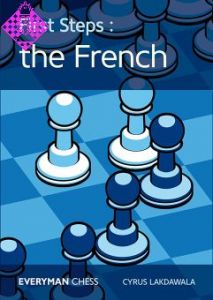 First Steps: the French21,95 €
First Steps: the French21,95 € -
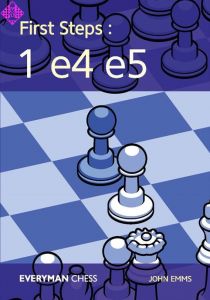 First Steps: 1 e4 e521,95 €
First Steps: 1 e4 e521,95 € -
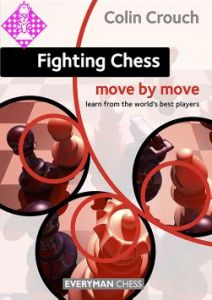 Fighting Chess: Move by Move22,95 €
Fighting Chess: Move by Move22,95 € -
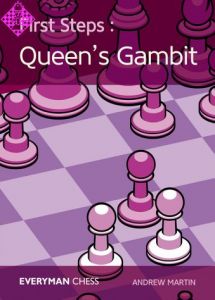 First Steps: Queen´s Gambit22,50 €
First Steps: Queen´s Gambit22,50 € -
 First Steps: Fundamental Endings22,50 €
First Steps: Fundamental Endings22,50 € - Mehr von Everyman

